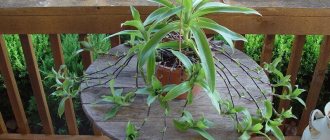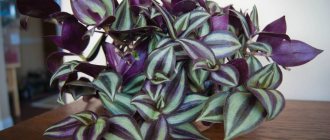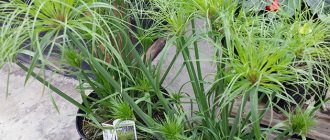The homeland of arrowroot is South America. This is a perennial herbaceous plant. Lovers of indoor flowers appreciate it for the unusual color of the leaf plate. It can be any shade of green.
The leaf has an oval shape, decorated with veins and spots of contrasting color. Arrowroot is a flowering plant; its flower forms a small spikelet.
Arrowroot tricolor
It is distinguished by red veins on the leaf blade. The color of the leaves also contains green and yellow. The reverse side of the sheet is painted crimson.
Types of domestic arrowroot with photos and names
The genus Maranta includes more than 40 species. Let's look at the most popular ones that can often be found on sale.
Arrowroot tricolor, tricolor
The oval leaves reach a length of 12-14 cm. The edges of the plates are light green, closer to the middle along the entire length there are swamp-colored spots. From the burgundy-red central vein, rays of the same color extend to the sides. The flowers are purple and small. The height of the bush does not exceed 35 cm.
Arrowroot white vein
This is a low plant with large leaves (up to 14 cm). The main color of the plates is dark olive. The midrib is pale green, with light blotches next to it along its entire length. Almost white “rays” emanate from the middle of the plate, which is why the plant got its name.
Arrowroot black Massanzha
The edges of the plates of this type of “praying grass” are green. The core of the leaves is light. Along it there are rows of spots of almost dark brown color. The plant reaches a height of 25-30 cm.
Maranta Kerkhovina
This is the most popular species among amateur gardeners. The leaf blades have a uniform green color and veins do not stand out on them. There are two rows of brown spots of irregular shape along the entire length.
Some consider arrowroot a capricious plant. This is not an entirely true statement. It is not at all difficult to comply with the above parameters. It is enough to devote 5-10 minutes daily to the “praying grass” so that it pleases the gardener with lush, spectacular foliage.
Light
The arrowroot plant loves light, but direct sunlight can be harmful to it. If there is too much light, the color of arrowroot leaves may lose its brightness and richness.
If there is not enough light, the leaves will be small and inconspicuous. Experienced gardeners recommend placing the pot with the plant on the western or eastern side, where there is diffused sunlight.
If there is enough lighting, then its leaves will be located horizontally, and in low light they will begin to stretch vertically.
Flowering beauty - signs
Arrowroot does not bloom very often indoors. Its flowers are not particularly beautiful and often gardeners simply cut off the flower stalks so that the flower does not waste energy on them. Flowers of three petals are usually white or cream in color, not densely planted on the shoot.
According to popular beliefs, arrowroot is capable of:
- Improve the financial condition of the family where the flower lives. If a flower decides to bloom, it portends an improvement in financial condition, making a big profit, or winning the lottery.
- Remove negativity in the family between spouses or children and parents. Normalizes the atmosphere of the house, bringing comfort and tranquility.
- Stabilize the condition of a sick person. By absorbing all the negativity and renewing the biofield, a flower placed at the head of a sick person promotes a speedy recovery.
A wonderful flower can decorate any home
The plant is not demanding and is suitable even for novice gardeners. Compact, bright and exotic, it is able to bring tropical notes into the comfort of home.
Moisture
Arrowroot loves moisture, but it is better not to water it abundantly, but to spray it frequently, at least twice a day. The soil should be slightly moist; in winter, even dry soil is allowed.
It is recommended to use purified warm water when watering to avoid limescale deposits on the leaves. You can also place the plant next to the aquarium to maintain the required humidity.
Table: conditions for arrowroot in different seasons
| Season | Lighting | Temperature | Humidity |
| Spring Summer | Scattered light. Grows well in partial shade, on eastern and western windowsills. In summer and spring it is necessary to protect from direct sunlight. Excessive sunlight changes the color of leaves. | Air temperature - 22–25°C, soil temperature - 18°C. | Daily spraying using settled water. Once a week - shower (cover the soil in the pot with a bag and place the plant under a spray of water). Place on a tray with damp pebbles. |
| Autumn winter | 17–19оС (should not fall below 10оС). It is necessary to protect from sudden changes in temperature and drafts. | Moderate humidity. |
Top dressing
To strengthen and grow well, it is necessary to water the arrowroot, adding mineral and organic substances to the water. In summer this is done twice a month, in winter once is enough.
Considering that arrowroot comes from the tropics, it is recommended to create an appropriate climate at home for comfortable growing conditions for this beautiful plant. If these requirements are met, the plant will always have bright and lush foliage.
Table: diseases and pests of arrowroot
| Diseases and pests | How do they manifest themselves? | Prevention measures | Control measures |
| Spider mite | Looks like a small red spider. As a result of its activity, a thin web is formed between the leaves of the plant. Elevated temperatures and dry environments are excellent conditions for ticks to appear. |
|
|
| Mealybug | Favorite habitat and damage are leaf petioles. |
| |
| Chlorosis | The leaves turn yellow, fall off, and new ones grow small. The shoots dry out. The roots are dying. |
|
How to recognize diseases and pests of arrowroot: tips in the photo
Spider mites stretch webs between plant leaves
Chlorosis weakens the entire plant
Favorite habitat and damage - leaf petioles
Transfer
Arrowroot is usually planted in plastic pots, since ceramic ones contribute to hypothermia of the tubers in winter. The pot itself should be wide enough. It is necessary to place drainage at the bottom, then use loose soil mixed with sand or peat.
It is recommended to do the first transplant after three years. Subsequently, the young plant is replanted in the spring every year, and then, if necessary, the flower pot is replaced with a more spacious one. But at least once every four years.
- Advantages of Gardena gardening equipment
Bathhouse made of 6x6 timber
- Ktenanta - types, cultivation characteristics and instructions for care at home. 110 photos of plants
Diseases
There are no specific diseases unique to the arrowroot family. All problems are caused by simple carelessness of the owner or failure to comply with mandatory care conditions.
Any ailment of the arrowroot will be clearly demonstrated by its appearance. There is a high probability that growth will stop. All this is provoked by three main reasons: root rotting, insect damage and insufficient air humidity.
The fact that rotting has occurred in the root system can be recognized by wilted leaves in wet soil. Most likely, the flower suffers from low temperatures due to abundant watering or poor-quality soil. To eliminate the problem, it is necessary to dry the soil, eliminate the affected areas and establish a proper watering regime. In some cases, it makes sense to transplant the arrowroot into a new sterilized substrate.
Reproduction
There are two types of arrowroot propagation:
- Separation when transplanting tubers.
In this case, a tuber with roots and several leaves is selected. Place in a prepared pot with moistened soil and cover with film for several days to maintain the required humidity.
- Cuttings.
At the beginning of summer, a small cutting with two to three leaves is cut from the tops of the shoots and placed in a container with water. Once the roots appear, it will be possible to plant them in a separate pot. In addition, pruning elongated shoots allows you to form the desired shape of the plant and also promotes the appearance of new leaves.
Description
Arrowroot is an ornamental herbaceous perennial from the Marantaceae family. It is named after the medieval physician and botanist Bartolomeo Maranta. Sizes and appearance vary greatly depending on the variety. At home you can rarely find arrowroot taller than 30 cm, however, in natural conditions the height of the bush can reach one and a half meters. The leaves are large, patterned, and oval in shape. A young specimen has erect stems, but with age they lean more and more toward the ground.
This is interesting! With the onset of darkness, arrowroot raises its leaves to the sky, exposing their back side. This is very reminiscent of a believer folding his hands in prayer. This is where the plant got its second name - “Prayer Plant”. Arrowroot also has a third name, and, oddly enough, it is also associated with religion. The shape of the leaves resembles the tablets of Moses, and each leaf has 10 spots, just like the number of commandments on the tablets. That’s why some people call arrowroot the “10 Commandments.”
The root system of arrowroot is represented by tubers. The tubers of some arrowroot species are edible and are cultivated in several countries. Starch is also extracted from them for use in medicine.
This may be interesting: Caring for arrowroot at home
Arrowroot blooms in summer. Rare inflorescences appear from the top of the plant. The petals come in white, yellow and pink colors. After pollination, small seed pods appear in place of the flowers. Small, inconspicuous arrowroot flowers cannot compete with the beautiful leaf pattern, so most often they are removed at the formation stage so that the plant does not waste extra energy on flowering.
Features of care
What is home care? The photo with arrowroot shows how attractive this plant can grow. However, it is worth paying attention to the fact that this crop is very capricious in care and cultivation. The homeland of this plant is the tropics, therefore, if the arrowroot is not provided with the appropriate conditions, it will not forgive any mistakes, as a result of which it will not be possible to grow a beautiful and healthy flower at home.
Above was a description of some varieties of arrowroot with photos. Caring for a plant at home requires compliance with certain rules, so you should carefully select the variety for breeding.
Trimming
Pruning arrowroot will encourage new and more vigorous growth. Don't be afraid to prune more than necessary, the plant will eventually grow back.
Use garden shears for pruning. Just make sure they're clean before you start so you don't spread disease or pests.
Cut stems just above leaf nodes to encourage new shoots to form just below the cut point.
Care during the winter months
As with most houseplants, arrowroot goes dormant during the winter. Growth slows down or stops altogether, and this is completely natural. Reduce watering during this period and stop fertilizing. But it is necessary to maintain a high level of humidity.
As spring arrives and the plant awakens from dormancy, you will notice signs of growth. This is a sign that feeding needs to be resumed.
Plant cleaning
Arrowroot leaves, like any other plant, must be kept clean. When they become dirty, gently wipe them with a soft, dry cloth to remove dust.
The soil
You can use a ready-made mixture for indoor plants; it includes peat moss, sand and loam. If you are using rich soil, add some perlite or coarse sand to the mixture. Use these proportions:
- 1 part perlite or coarse sand;
- 1 part garden soil;
- 1 part peat or humus;
- 1 pinch of lime.
To improve drainage, add rocks or gravel to the bottom of the pot and make sure it has a drainage hole.











